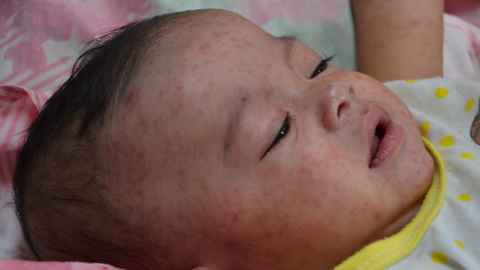Samoa’s devastating measles epidemic – why and how bad?
29 November 2019
Opinion: With the death toll rising in Samoa's measles epidemic, vaccinologist Dr Helen Petousis-Harris explores why Samoa's immunity is so low and how bad the epidemic could get.

Samoa are experiencing a devastating measles epidemic. It is possible that 2-3% of the population will ultimately be infected by the time it is over. Hopefully the mass immunisation campaign currently under way can mitigate some of this; for many it is too late.
The first question many people ask is “why?”
The general answer is simple. Samoa has long term low immunisation coverage—some of the lowest vaccination rates in the world. This low immunisation coverage has left Samoa extremely vulnerable to measles—a lit match to dry tinder and gasoline. With the global resurgence of measles, the risk of an importation to this vulnerable community was almost inevitable.
This low immunisation coverage has left Samoa extremely vulnerable to measles—a lit match to dry tinder and gasoline.
Why has the coverage been so low?
There is a degree of distrust by the Samoan community in the health system. This is not entirely misplaced. Events last year highlighted some of the issues with the health practices when two infants were administered a muscle relaxant drug when it was used to reconstitute a five-dose vial of MMR vaccine instead of water. Both infants died within minutes of injection. The grave errors that led to this occurring are monumental both in number and in magnitude.
Following this tragic event the immunisation programme was halted for months. The public were not informed that it was not a vaccine that caused the deaths. The anti-vaccine movement thrived, spreading misinformation, and vaccine coverage plummeted further. The Washington Post highlighted some of the behaviour and it is pretty disgusting. Alison Campbell has discussed some of the "claims" (i.e. lies) spread by those who prey.
Other factors contributing to the magnitude of this epidemic
There are two tools available to us to control epidemics such as measles. One is employing isolation and quarantine, the other is through rapid mass vaccination.
These interventions must occur swiftly. If there is no disease in the community, a single case can be considered an outbreak. Once secondary cases appear it is most definitely an outbreak. Some 200 cases had appeared before Samoa declared a problem. Even though the first cases appeared in August, a mass immunisation campaign has only just begun. These things together have contributed to the magnitude of this epidemic.
Why are so many children dying?
The average mortality rate for measles in low/middle income settings is around 2 per 100 cases. I have also read some literature that suggests mortality is higher when cases are clustered close together—such as when immunisation coverage is very low—and it may have something to do with infective viral load.
The death rate we are seeing is not unexpected for a setting such as Samoa. Here is an interview with one of the Australian doctors on the ground; he explains the sort of complications they are dealing with in intensive care.
It is important to keep in mind the level of health care and access to health care in Samoa is not the same as it is in New Zealand, and that there were a few near deaths in New Zealand during this last epidemic.
It is important to keep in mind the level of health care and access to health care in Samoa is not the same as it is in New Zealand.
How much worse will the Samoan epidemic get?
Predicting is never easy without a crystal ball. However, past, present, and future epidemics can be modelled using mathematics. The more information/data you have about the disease and the population, the better the model.
To estimate the trajectory of the Samoan epidemic, researchers David Wu, Dr Oliver MacLaren and Dr Vinod Suresh (Department of Engineering Science and Auckland Bioengineering Institute) used some techniques they have been developing recently. The model uses the number reported cases from Samoa’s National Emergency Operations Centre releases, and to keep it simple it does not use the age/spatial information (because it would become much harder to estimate). In other words, it’s quite a simple model that doesn’t capture all the complexity of the outbreak.
Based on the information available the model predicts a total of 4500-6500 cases, with almost all the remaining cases occurring in the next month—95% of these within 2-3 weeks and 99% within a month. With current mortality rates (1.3% of reports), we expect around 70 deaths. This is in the absence of the mass campaign now ramping up.
With further information the model can be refined. However, right now this is the best estimate available.
I hope they have enough vaccines in Samoa by now to change this trajectory.
Dr Helen Petousis-Harris is a vaccinologist and senior lecturer in the University of Auckland’s Faculty of Medical and Health Sciences.
This article reflects the opinion of the author and not necessarily the views of the University of Auckland.
Used with permission from SciBlogs, Samoa’s devastating measles epidemic – why and how bad? 28 November 2019.
Media contact
Nicola Shepheard | Media adviser
DDI: 09 923 1515
Mob: 027 537 1319
Email: n.shepheard@auckland.ac.nz